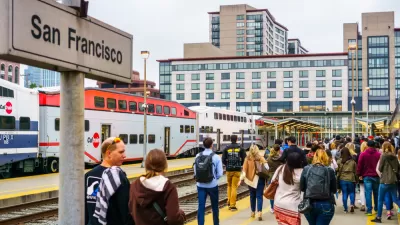Should a packed commuter train remove seats to make room for cyclists or charge to bring bikes on board during peak hours? The Caltrain line between San Francisco and Silicon Valley, the first to accommodate cyclists, is wrestling with this issue.
"'Leaving San Jose anytime between 5 and 7 (p.m.) is just nuts,' said Robert Cox, who rides the train there from his home in Redwood City. 'I've seen people get bumped a lot and it's just going to get worse.'
That's not news to Caltrain, which recently completed a report that recommends several possible solutions such as building more bike lockers at stations, starting a bike sharing program or charging a fee for allowing bikes during peak ridership hours.
But bikers, who now make up an estimated 8 percent of Caltrain's weekday riders, say the report misses the point, and that the train services should free up some space for their bikes either by removing more seats or adding more train cars."
"Caltrain's Bicycle Parking and Access Plan, released last week, gives a broad look at issues bicyclists face when using Caltrain.
It was initially called the Bicycle Master Plan, but cyclists complained that it focused on parking and access at Caltrain stations and ignored the 80 percent of cyclists who carry their bikes on the train. So the name was changed, but bikers say the focus didn't change much."
"The (San Francisco Bicycle) coalition crafted its own bicycle plan, which it distributed to Caltrain board members at a recent meeting. (Andy) Thornley, (program director) said he hopes officials will consider their suggestions, including taking out more seats".
Caltrain: Bike Plan Available for Review
Planetizen: Bikes on Trains: The Downside Of A Popular Program
SF Bicycle Coalition: Caltrain and Bikes - Have you been left behind?
FULL STORY: Riders say bike plan falls short

Alabama: Trump Terminates Settlements for Black Communities Harmed By Raw Sewage
Trump deemed the landmark civil rights agreement “illegal DEI and environmental justice policy.”

Planetizen Federal Action Tracker
A weekly monitor of how Trump’s orders and actions are impacting planners and planning in America.

The 120 Year Old Tiny Home Villages That Sheltered San Francisco’s Earthquake Refugees
More than a century ago, San Francisco mobilized to house thousands of residents displaced by the 1906 earthquake. Could their strategy offer a model for the present?

In Both Crashes and Crime, Public Transportation is Far Safer than Driving
Contrary to popular assumptions, public transportation has far lower crash and crime rates than automobile travel. For safer communities, improve and encourage transit travel.

Report: Zoning Reforms Should Complement Nashville’s Ambitious Transit Plan
Without reform, restrictive zoning codes will limit the impact of the city’s planned transit expansion and could exclude some of the residents who depend on transit the most.

Judge Orders Release of Frozen IRA, IIJA Funding
The decision is a victory for environmental groups who charged that freezing funds for critical infrastructure and disaster response programs caused “real and irreparable harm” to communities.
Urban Design for Planners 1: Software Tools
This six-course series explores essential urban design concepts using open source software and equips planners with the tools they need to participate fully in the urban design process.
Planning for Universal Design
Learn the tools for implementing Universal Design in planning regulations.
Clanton & Associates, Inc.
Jessamine County Fiscal Court
Institute for Housing and Urban Development Studies (IHS)
City of Grandview
Harvard GSD Executive Education
Toledo-Lucas County Plan Commissions
Salt Lake City
NYU Wagner Graduate School of Public Service





























